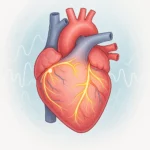
Tightness in Chest Symptoms and What They Could Mean
Clinical Meaning of Tightness in Chest
Defining Chest Tightness
The term tightness in chest refers to a sensation of pressure, squeezing, or heaviness felt anywhere between the neck and the upper abdomen. Clinically, it falls within the broader category of chest pain or discomfort, which clinicians assess using standardized diagnostic pathways. Because this symptom can vary from mild constriction to intense compression, it is approached with the same level of medical attention as other forms of chest pain.
Discomfort may not always be limited to the chest itself. Some individuals experience referred sensations extending to these areas:
- Arm
- Neck
- Jaw
- Back
- Upper abdomen
These overlapping pain patterns make structured clinical evaluation essential to determine the underlying source rather than relying on sensation alone.
Myth vs Fact: Is All Chest Tightness Cardiac?
A frequent misconception is that any feeling of tightness in chest automatically signals a heart problem. While cardiac causes are among the most serious possibilities, they represent only a fraction of overall cases seen in medical practice. In many instances, chest tightness arises from noncardiac conditions that, while uncomfortable, are less dangerous.
| Myth | Fact |
|---|---|
| All chest tightness means a heart attack. | Most cases are not cardiac; musculoskeletal or reflux-related conditions are frequent in low-risk patients. |
| Noncardiac tightness is harmless and needs no attention. | Even noncardiac symptoms require assessment to exclude serious causes and manage discomfort appropriately. |
Clinicians frequently identify musculoskeletal pain or reflux-related disorders as the source in low-risk individuals. These conditions can mimic heart-related symptoms but usually follow patterns such as pain linked to movement, posture, or meals. Recognizing these distinctions reduces unnecessary alarm while ensuring that high-risk symptoms receive prompt attention.
Epidemiologic Overview
Chest pain and tightness are among the most common reasons people seek medical care, in both emergency and primary care settings. However, only a small proportion of these cases are ultimately diagnosed as acute coronary syndromes or other serious cardiac conditions. This highlights the need for balanced evaluation-remaining alert for life-threatening disease while recognizing the many benign explanations that account for most presentations.
In clinical data, noncardiac causes such as chest wall strain and gastroesophageal reflux disease are leading diagnoses, especially among otherwise healthy or low-risk patients. This reinforces that chest tightness is a symptom shared across several body systems and that careful medical assessment remains central to safe management.
Cardiac Causes of Tightness in Chest
Ischemic Heart Conditions
Cardiac-related chest tightness most often results from inadequate blood flow to the heart muscle, known as ischemia. This imbalance between oxygen supply and demand underlies several key conditions: acute coronary syndromes, stable angina, and nonobstructive ischemic syndromes. Despite differences in severity, they share a mechanism of reduced coronary perfusion leading to myocardial stress and pain.
- Acute coronary syndromes: Sudden restriction of blood flow, often signaling an evolving heart attack.
- Stable angina: Occurs with exertion or emotional stress and typically resolves with rest or medication.
- Nonobstructive coronary syndromes: Present similarly but arise from microvascular dysfunction rather than blockage of large arteries.
Though these ischemic types differ in urgency, each reflects insufficient oxygen delivery to the heart muscle.
Recognizing Ischemic Patterns
Ischemic chest tightness is often described as a diffuse pressure, heaviness, or squeezing that can radiate to the shoulder, arm, neck, jaw, or upper abdomen. Symptoms often occur during exertion or emotional stress and may be accompanied by shortness of breath, sweating, or nausea. Because this discomfort is visceral and not sharply localized, it may be mistaken for indigestion or fatigue.
- Diffuse or squeezing pressure sensation
- Radiation to arm, neck, jaw, or upper abdomen
- Associated shortness of breath, sweating, or nausea
- Triggered by exertion or emotional stress
- Relieved by rest in stable cases
Clinicians analyze the pattern of onset and associated features to distinguish ischemic from nonischemic pain. Episodes triggered by physical or emotional stress and relieved by rest suggest coronary disease, while persistent tightness at rest may indicate a more serious process requiring urgent care.
Fact Focus: Cardiac vs Noncardiac Presentation
| Feature | More Suggestive of Cardiac Origin | Less Suggestive of Cardiac Origin |
|---|---|---|
| Relation to activity | Triggered by exertion or stress | Triggered by movement or posture |
| Pain quality | Pressure, heaviness, squeezing | Sharp, localized, or reproducible by touch |
| Relief pattern | Improves with rest or medication | Changes with position or breathing |
Although many cases of chest tightness stem from noncardiac sources, specific clinical cues make a cardiac cause more likely. Pain that varies with body position, breathing, or palpation is less indicative of ischemia, though in high-risk patients atypical or mild ischemic presentations can still occur. Recognizing these distinctions allows for appropriate triage and timely medical attention.
Noncardiac Causes of Tightness in Chest
Musculoskeletal and Gastroesophageal Sources
Not all chest tightness originates from the heart. Musculoskeletal conditions of the chest wall are among the most common noncardiac causes. Discomfort may arise from muscle strain, costochondritis, or minor injuries affecting the ribs or intercostal muscles. The pain is typically localized and reproducible by palpation or movement, helping distinguish it from diffuse ischemic discomfort.
- Localized tenderness that worsens with movement or palpation
- Pain from muscles, joints, or connective tissue around the ribs
- Mechanical pain differing from diffuse, exertional cardiac discomfort
Gastroesophageal causes, such as gastroesophageal reflux disease (GERD) or esophageal spasm, can also produce chest sensations similar to cardiac pressure or burning. These often relate to meals, lying down, or heartburn episodes. Irritation or spasm of esophageal muscle can generate central chest discomfort because the esophagus and heart share similar nerve pathways, sometimes making distinction difficult.
- Symptoms linked to eating, recumbency, or heartburn
- Central burning or pressure from esophageal irritation or spasm
- Overlap with cardiac pain due to shared nerve pathways
Pulmonary and Anxiety-Related Causes
Respiratory conditions such as pulmonary infection, inflammation, or airway constriction can also cause pressure-like chest sensations. These are often accompanied by cough, shortness of breath, or pleuritic pain that worsens with deep breathing, helping distinguish them from cardiac causes.
- Pain worsens with breathing or coughing
- Often accompanied by cough or shortness of breath
- Indicates pulmonary rather than cardiac involvement
Psychogenic or anxiety-related mechanisms frequently produce real sensations of tightness in the chest. During anxiety or panic episodes, rapid breathing, muscle tension, and altered chest wall movement can create a sense of constriction even in the absence of heart or lung disease. Understanding this physiological link helps patients manage symptoms more effectively.
Myth vs Fact: Can Stress Alone Cause Tightness?
| Myth | Fact |
|---|---|
| Chest tightness from stress is purely psychological and unimportant. | Stress and anxiety can produce genuine physical sensations through hyperventilation, muscle tension, and altered breathing. |
| Stress-related tightness means a heart problem. | Such sensations often occur without cardiac disease but still warrant evaluation to rule out other causes. |
Recognizing the physiological basis of stress-induced chest tightness helps normalize the experience and supports reassurance and appropriate evaluation.
Red Flags and Diagnostic Evaluation of Chest Tightness
Red-Flag Symptoms and High-Risk Profiles
Chest tightness can have many causes, but certain symptom patterns require immediate medical attention. Red-flag signs include sudden, severe pain or pressure; radiation of discomfort to the arm, neck, jaw, or back; fainting; marked shortness of breath; and evidence of hemodynamic instability such as low blood pressure or rapid pulse. These may signal a life-threatening condition such as acute coronary syndrome, pulmonary embolism, or aortic dissection.
- Sudden, severe onset of pain or pressure
- Radiation to arm, neck, jaw, or back
- Fainting or near-syncope
- Severe shortness of breath or difficulty breathing
- Low blood pressure or rapid pulse suggesting instability
Clinicians also evaluate overall risk profiles. Age, cardiovascular risk factors, and any history of heart disease influence the likelihood that tightness in the chest is cardiac in origin. Assessing these factors helps estimate pretest probability and determine how urgently testing is required.
| Risk Factor | Clinical Relevance |
|---|---|
| Older age | Increases likelihood of coronary artery disease |
| Hypertension or diabetes | Contributes to vascular and cardiac strain |
| Smoking history | Raises risk of ischemic and pulmonary conditions |
| Known heart disease | Increases probability of recurrent ischemia |
Clinical Evaluation Steps
Initial evaluation includes a focused history and physical examination. Clinicians assess onset, duration, and triggers of tightness in chest, along with associated symptoms such as shortness of breath, nausea, or palpitations. Examination emphasizes vital signs, oxygen levels, and evidence of heart or lung issues. This step guides triage between urgent intervention and outpatient management.
- Gather detailed symptom history
- Assess vital signs and oxygen saturation
- Perform 12-lead ECG to evaluate cardiac activity
- Interpret findings rapidly to guide next steps
Prompt ECG testing is critical when cardiac causes are possible. The ECG may show signs of ischemia or arrhythmia, guiding immediate management. Combined with careful history and examination, ECG interpretation forms the foundation of early diagnosis.
Diagnostic Tests and Imaging
After initial evaluation, diagnostic testing depends on suspected cause and risk level. Cardiac biomarkers such as troponin help detect myocardial injury. Imaging-chest X-ray or computed tomography (CT)-can reveal pulmonary infection, effusion, or aortic dissection. For suspected pulmonary embolism, clinicians use D-dimer testing or CT pulmonary angiography.
- Cardiac tests: Troponin, ECG
- Imaging: Chest X-ray, CT scan, echocardiography
- Specialized tests: D-dimer or CT angiography for embolism
This stepwise, evidence-based approach ensures rapid identification of critical causes while minimizing unnecessary testing in low-risk cases.
Guided Management and Patient Awareness for Tightness in Chest
Risk Stratification and Clinical Decision Pathways
Modern clinical guidelines emphasize structured decision pathways to evaluate tightness in chest efficiently and safely. These pathways integrate clinical variables, patient history, and test results-particularly high-sensitivity troponin measurements-to stratify patients into low, intermediate, or high-risk categories for acute coronary syndromes. This standardized approach ensures that urgent cases are identified quickly while unnecessary hospitalizations are minimized for those with benign or noncardiac causes.
- Low-risk: Managed with limited investigations and short-term observation or outpatient follow-up.
- Intermediate-risk: Requires monitored evaluation and serial troponin testing to confirm or rule out cardiac injury.
- High-risk: Necessitates immediate medical intervention and advanced imaging to address possible myocardial damage.
This tiered system helps clinicians balance prompt intervention with efficient resource use, improving both patient outcomes and overall safety in managing chest tightness.
When to Seek Immediate Help
Patients should seek urgent medical attention if tightness in chest is new, severe, or accompanied by symptoms such as shortness of breath, sweating, nausea, fainting, or pain radiating to the arm, jaw, or back. These signs may indicate a serious cardiac event requiring emergency evaluation. Persistent or worsening discomfort, especially at rest, also warrants prompt assessment to exclude evolving ischemia or other life-threatening conditions.
- New or worsening chest tightness or pressure
- Shortness of breath, sweating, or nausea
- Fainting or light-headedness
- Pain radiating to the arm, jaw, neck, or back
- Chest discomfort at rest or unrelieved by rest
Clinicians play an essential role in reinforcing awareness of these warning signs during consultations. Clear communication helps patients understand when self-observation is appropriate versus when immediate emergency care is necessary, minimizing delays in diagnosis and treatment.
Ongoing Care for Noncardiac Causes
For individuals whose tightness in chest arises from noncardiac causes, management focuses on addressing the underlying condition while remaining alert for new or changing symptoms. Reflux disease, anxiety, or musculoskeletal strain often respond to targeted therapy, lifestyle modification, or physical intervention under clinical guidance. Patients are encouraged to maintain regular follow-up to monitor progress and ensure symptom stability.
Education about the typically benign nature of many noncardiac causes can reduce anxiety and improve adherence to treatment plans. By understanding both the importance of red-flag awareness and the reassurance of low-risk findings, patients gain confidence in managing their symptoms and knowing when to seek care.
Frequently Asked Questions About Tightness in Chest
- Is chest tightness always a sign of heart disease?
- No. While heart conditions like angina or heart attacks can cause tightness, many cases result from muscle strain, reflux, anxiety, or respiratory issues.
- When should chest tightness be treated as an emergency?
- Seek urgent help if the tightness is sudden, severe, or occurs with shortness of breath, fainting, nausea, or pain radiating to the arm or jaw.
- Why can anxiety or stress cause a feeling of tightness in the chest?
- During stress or panic, rapid breathing and muscle tension can create a real sensation of constriction, even without heart or lung disease.
- Can chest tightness happen without pain?
- Yes. Some people feel pressure or heaviness rather than pain. This can still indicate heart or noncardiac conditions that require evaluation.
- How do doctors determine the cause of chest tightness?
- Clinicians review medical history, assess risk factors, and perform tests such as ECG, troponin measurement, or imaging to identify the source accurately.
- Are noncardiac causes of chest tightness serious?
- Most noncardiac causes, like reflux or muscle strain, are not life-threatening but should be confirmed by a doctor to rule out cardiac conditions.
- Does tightness that worsens with movement usually mean a muscle problem?
- Often yes. Pain that changes with movement or touch is more typical of musculoskeletal causes rather than heart-related problems.
- Can digestive problems mimic heart-related chest tightness?
- Yes. Acid reflux and esophageal spasms can produce central chest pressure or burning that feels similar to cardiac discomfort.
- What tests are done first when chest tightness is reported?
- Initial steps usually include a physical exam, vital sign assessment, and an ECG to quickly check for signs of ischemia or arrhythmia.
- How can patients manage ongoing, noncardiac chest tightness?
- Treatment focuses on addressing the underlying issue-such as managing reflux, anxiety, or muscle tension-while maintaining follow-up to monitor changes.




















